The cast shadows darkened a bit in the process, but here’s a lighter, higher contrast version to make it easier to see (I added the outline):
And here’s a version (below) with a little more space around the objects and straightening them up, so they’re not sliding off the table. There’s a certain charm in that, but it does make for an unstable composition. I think the added space around them gives them a stronger sense of what you’re after–objects isolated not only from one another but from the border (space around them) as well.
This reminds me of the famous Saul Steinberg drawing (a New Yorker cover from 1976), of a New Yorker’s view of America. Your objects have a similar child-like charm, and even your style and lettering (as well as the eye level, looking down) are reminiscent of his–great company to be in:
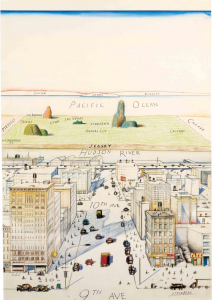 (that empty space at the top is for the name of the magazine).
(that empty space at the top is for the name of the magazine).
Yours also reminds me of the work of Roger Brown, especially the silhouettes in the windows, but also that view from above:
His was done years ago (1991), but has a prescient sense of social isolation.
Finally, yours reminds me of a tableau that our daughter made a couple of weeks ago, using paper-covered cereal boxes and such, suggested by Mo Willems on his Lunch Doodles telecast:
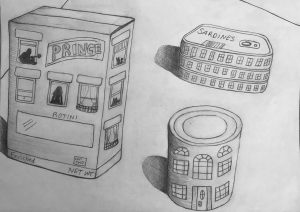
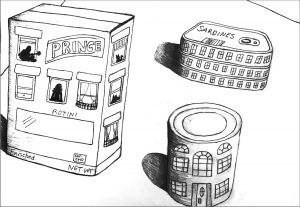
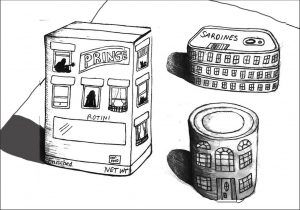
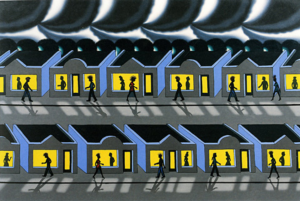
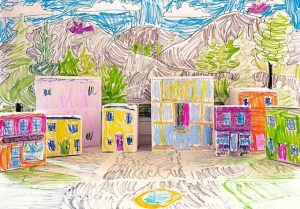
I like the concept for this drawing, but I’m not as proud of how it turned out mostly because I think I got in a bit over my head of how complex it would be. There’s a lot going on. At first I was just going to draw the pasta box and the cans far away from each other 1. because cans and pasta are such a staple product these days, and 2. it’s a little unsettling to see these items which are usually stored in close quarters so spread out. This last bit obviously symbolize how unsetting is is for people to be spread out these days. I then had the idea to make them houses and/or apartments because of the imagery of feeling like you are trapped in a tin can or packed in like sardines. I often get overwhelmed with “creative” assignments like this just because I find myself going down a rabbit hole of ideas and I have a hard time bringing it all in. You can probably tell that from the drawing. At the very least I think it’s a fun drawing and I enjoyed making it.
I completely relate to the feeling of falling down the rabbit hole of ideas. On one hand it could be useful to take a careful look at composition and write/draw all of your ideas out through small prototypes to get a feel of each. On the other hand, sometimes letting the ideas flow during the drawing is part of the fun, especially during this stage where we’re learning and finding what is meaningful to us! I love the concept and think you did a really good job of getting the darkest of darks, which I have a tendency to lean away from rather into. The little details are also really engaging! I might suggest revisiting what we learned about cylinder anatomy to make sure the ellipses are in line. Also, I am unsure if the 3d perspective of the objects correlates spatially with the surface, which appears less flat.
Like Devon said, I definitely know what you mean when coming up with ideas for projects. However, I do think this is a really creative idea – one that combines many relevant components of life right now. It’s also tough to experience the complete pictures right now because even the best editing cannot replicate seeing a drawing in person. However, I think the edited photos that were added do add a lot to your initial drawing. The shadowed people in the left “building” add to the landscape. Overall, I think it’s really important to keep taking these creative risks, even if you don’t know what the final product will look like.
Hi Grace,
Apologies for the slow reply. Most of my comments are above, with the attachments I’ve added, but in a nutshell you needed to have more fun with this. You were on to something when you started turning them into buildings, conflating a domestic scale scene (our private world) with a cityscape (a public one)–very clever.
You mention having too many ideas, but the best ideas are the ones (like the one just mentioned), that happen organically and intuitively through the drawing process. Drawing is not just a recording method for pre-determined ideas but a way of thinking. You can trust that–start by drawing just about anything and see where it takes you.
But when something begins to take shape, the next job is to hone and amplify that idea (as I’ve tried to exemplify with my example above).